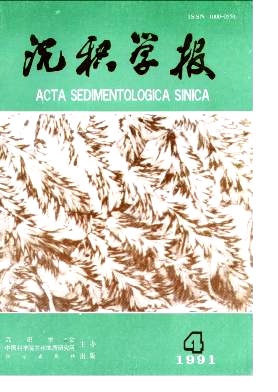Mei Zhichao, Lin Jinyan. Stratigraphic Pattern and Character of Skeletal Sand Bodies in Lacustrine Deltas[J]. Acta Sedimentologica Sinica, 1991, 9(4): 1-11.
| Citation:
|
Mei Zhichao, Lin Jinyan. Stratigraphic Pattern and Character of Skeletal Sand Bodies in Lacustrine Deltas[J]. Acta Sedimentologica Sinica, 1991, 9(4): 1-11.
|
Stratigraphic Pattern and Character of Skeletal Sand Bodies in Lacustrine Deltas
- Received Date: 1991-03-12
- Publish Date:
1991-12-10
-
Abstract
Large lacustrine deltas are mainly formed in the shore area of fresh or low salinity lakes. They are usually interpreted as the type of Mississippi river-dominated deltas because of low wave energy and lacking of tidal effect. The development of a complete progradational sequence is used as an important criterion for the identification of such deltas in subsurface geological study, and the river mouth bars are considered as an essential genetic facies which marks the site of major accumulation of sand deposits and represents a favourable fades zone for hydroncarbon accumulation. Based on observation and analysis of modern and ancient lacustrine deltaic deposits, the authors suggest that the marine Mississippi delta can not be used as a universal model for lacustrine deltas. The majority of lacustrine deltas in the subaerial basins bearing oil and gas of China are formed in freshwater lakes. The bed load is translated into the lake far off the river mouth instead of constructing conspicuous river-mouth bars, because the density of river water ladden with sediments is usually greater than that of lake water and river can maintain a high speed after entering the lake. Even though any thin river-mouth bars are ever formed,they are likely to be eroded by latter river action which sometimes cuts deep into the basement of the lake. The skeletal sand bodies of lacustrine deltas are therefore composed mainly of river channel or distributary channel sands. The lacustrine deltas in the Oidos basm and other oil-bearing basins of China are subdivided into two basic types on the basis of their stratigraphic character, namely shallow-water platform delta with an incomplete progradational sequence and deep-water basin delta with a fairly complete and thick progradational sequence. The former is formed in the shallow shore area with a stable bassement. It progrades lakeward quickly and has a wide distribution with banded channel sand bodies. The latter is the product of delta prograding onto the deep basin filled with thick argillaceous deposits, and its extent of distribution is often limited due to destruction by slumping, occurring chiefly in podiform river-channel sand bodies thickened as the result of subsidence. The deltaic system in large lake basins passes in space from the shallow-water into the deep-water type and in time from the deep-water into the shallow-water type as the basin becomes increasingly filled.
-
References
|
[1]
|
(1) 马力,1988,碎屑岩沉积相研究,石油工业出版社.第18-31页
(2) 王衡鉴等,1981,石油与天然气地质,第2卷,第3期.?227-341页
(3) 朱海虹等,1981.石油与天然气地质,第2卷,第2期,89-102页
(4) 孙顺才等,1981,科学通报,第4期,678-681页
(5) 吴崇摘,1983,沉积学报,第1卷,第期.5-26页
(6) 昊崇摘,1986,沉积学报.第4卷,第4期,1-127页
(7) 陈景维等,1983.石油地质文集(沉积相),第7期,地质出版社,257-266页
(8) 郑浚茂等,1988,碎屑岩沉积相研究.石油L业出版社,第182-191页
(9) 信荃麟等,1988.碎嚼岩沉积相研究.石油工业出版社,第192-204页
(10) 的赵翰卿等,1988.碎胃宕沉积相研究.石油工业出版社,205-215页。
(11) 黄第落等,1982,地质论评.第za卷,第3期,217-226页
(12) 梅志超等,1988,石油与天然气地质,第9卷,第3期.261-267页.
(13) 裘亦楠等,1986.石油勘探与开发,第1期,1一10页.
(14) 裘亦楠等,1980,石油学报(增刊),第I卷,73-93页.
(15) Coleman 1. M., 1982, Deltas. International human resources Development corporation, Houston.
(16) Donaldson A. C. et al., 1970, Deltaic sedimentation modern and ancient J. P. Morgan et al., eds) Soc. Econ. Paleont. Mineral. Spec. Publ. No. I5. Tulsa.
(17) Etliott T., 1978, Sedimentary environments and fades (H. G. Reading ed.). Blackwell Scientific Publication, Oxford.
(18) Fisher W. L. et al., 1969, Hur. Econ. Geol., Univ. Texas, Huston.
(19) Frideman G. M. et al., 1978, Principles of sedimentology. John Wiley and Sons, New York.
(20) Galloway W. E., 1975, Deltas, Models for Exploration(M. L. Broussard edJ.Houston Geol. Soc., Houston.
(21) Galloway W. E. et al., 1983, Terrigenous clasatic depositional systems. Springer-Verlag, New York.
(22) Haszeldine R. S., 1984, Sedimentology, V. 31.p.811-822.
(23) Sturm M. et al., 1978, Modern and ancient lake sediments (Matter A. et al., ed.) Blackwell Scientific Publication,Oxford.
(24) Wright L. D. et al.; 1974, J. Geol., V.82.p.751-778. |
-
-
Proportional views

-






 DownLoad:
DownLoad: